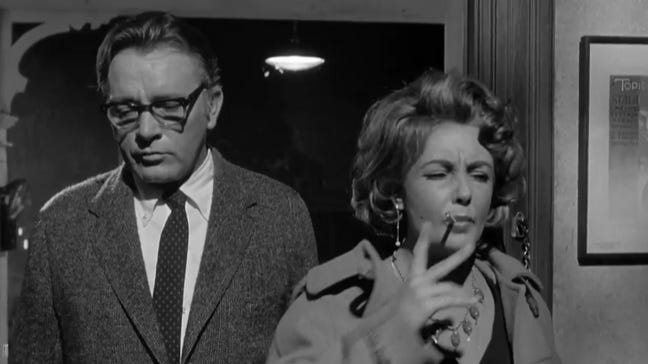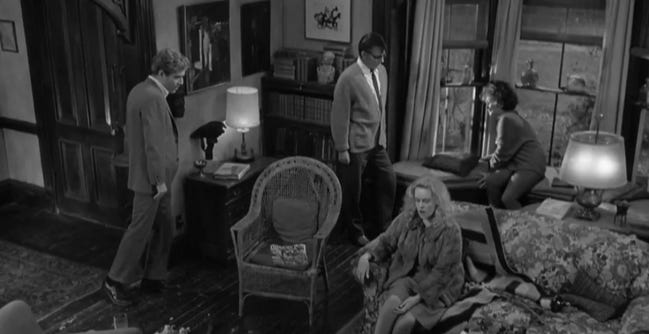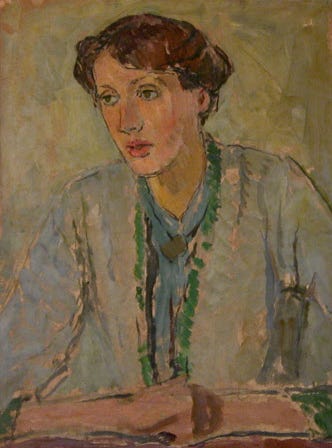Who's Afraid of Virginia Woolf? (1966)
I'm more exhausted by Virginia Woolf.
“H-WHAT A DUM-P,” Martha (Elizabeth Taylor) declares. She has a vague, distracted sloppiness about her, and her faded husband George (Richard Burton) incurs her ire when he can’t figure out the Bette Davis film she’s quoting. She snaps at him: “good grief, don’t you know anything?”1 It’s an appetizer to the alcohol-fueled vitriol that’ll consume them over the rest of the film.
It’s late and the drunken couple has just returned home from a college faculty party. New professor Nick (George Segal) and his wife Honey (Sandy Dennis) are on their way over for a nightcap and “fun and games”—which becomes a descent into petty rivalries and psychosexual dysfunction. The “games” have names like:
“Humiliate the Host”: Martha describes George’s professional failings.
“Hump the Hostess”: Nick takes Martha to bed but can’t perform.
“Get the Guest”: George reveals that Nick only married Honey because of her family’s money and her unplanned pregnancy (which Honey then secretly aborted).
Throughout the night, Martha brings up her son, whose birthday is tomorrow. In the film’s climax, we discover the son is imaginary (Martha couldn’t conceive) and George “kills” him, ending their shared fantasy.2
Rating: It’s two hours spent with the four worst people in the world, 8/10.
Cast and Crew
All things must end. Other than one uncredited appearance in our next Richard Burton movie, this’ll be our last ride with Elizabeth Taylor. But what a ride it has been! Father of the Bride, A Place in the Sun, Giant, Cat on a Hot Tin Roof, Cleopatra—you can’t say we didn’t get the Liz Taylor experience.
After Cleopatra, Taylor made lots more movies with husband Richard Burton—eleven in total. The late sixties and early seventies saw Taylor taking challenging roles of personal turmoil and self-destruction3, and though she remained one of the most famous people on the planet, her critical and commercial peak had passed.
We’ve mentioned husbands 1–5 in this newsletter4, but today we finish the story. Burton and Taylor divorced in 1974 but remarried in 1975 (so Burton is both husband #5 and husband #6). The pair were constant tabloid fodder, were both dealing with substance abuse problems, were incredibly in love, and were fighting enough to gain the nickname “the Battling Burtons.” They divorced again in 1976 and Taylor went on to marry Senate hopeful John Warner. She worked on his campaign and, when he won, she moved to Washington to star in the role of “Senator’s wife.” It didn’t suit her: she gained weight and saw her depression and addictions worsen. Warner and Taylor divorced and Taylor met her final husband, construction worker Larry Fortensky, while in rehab at the Betty Ford Center. They married in 1991.
Taylor’s final theatrical film was 1994’s live-action version of The Flintstones. She was nominated for a Razzie for her performance, but I’ve seen the film and she’s great in it. No, she’s more than great: she’s Liz freaking Taylor. Put some respect on the name.
George Segal had a long career in Hollywood, mostly with movies less highbrow than this one and Ship of Fools. He was a big star in the ‘70s, known for playing everyman characters in comedies and romances like The Owl and the Pussycat (1970), A Touch of Class (1973), and the original Fun with Dick and Jane (1977). His later career had him in supporting roles on TV’s “Just Shoot Me!” (1997–2003) and “The Goldbergs” (2013–2023). Segal was also an accomplished banjo player, but all the oxygen in the “actor/banjo” lane seems to be taken up by Steve Martin.
Quick Hits:
Sandy Dennis scored an Oscar for her performance as Honey. She later starred in two noteworthy New York films, Up the Down Staircase (1967) and The Out-of-Towners (1970). She was also a notable stage actress, winning Tonys for “A Thousand Clowns” and “Any Wednesday.”
Ernest Lehman served as screenwriter and producer. He’s screenwritten some films we’ve discussed in passing, including Sabrina (1954), North by Northwest (1959), West Side Story (1961), and The Sound of Music (1965), along with The King and I.
Another guy we haven’t mentioned but whose work we’ve seen is Alex North, composer extraordinaire for films like A Streetcar Named Desire, Viva Zapata!, and Cleopatra. He also wrote the song “Unchained Melody.”
The Trivia
So who’s this Virginia Woolf of whom we’re all so fearful? Born Adeline Virginia Stephen, Virginia Woolf (1882–1941) was a modernist British author. Her writing was typified by a laser focus on the inner lives of her characters and the use of stream-of-consciousness. “Woolf” was the surname of her husband, Leonard Woolf, with whom she founded Hogarth Press in 1917 to publish her works.
Woolf was perhaps the best-known member5 of the Bloomsbury Group, a coterie of artists and authors whose group was named for a district in London. Her sister Vanessa Bell was a painter and also part of the Bloomsbury Group.
A selection of Woolf’s works:
“Mrs. Dalloway” (1925). Clarissa Dalloway6 prepares to host a party while reflecting on her past loves, including Peter Walsh and her friend Sally Seton. Meanwhile, Septimus Warren Smith, a WWI vet with PTSD, commits suicide. It was originally called “The Hours,” and author Michael Cunningham took that name for his own book that featured Woolf as a character.7
“To the Lighthouse” (1927) details the visits of the Ramsay family to their summer home on the Isle of Skye. A kid wants to go to the lighthouse but his father won’t let him. Then, later, they go. (Yeah, her books aren’t really big on plot.)
Orlando: A Biography (1928). The title character is an English nobleman in Elizabethan England. Then he changes from a man to a woman and lives through the next 300 years without aging. Vita Sackville-West, Virginia Woolf’s lover, was the inspiration for Orlando.8
You should also know Woolf’s essay “A Room of One’s Own” (1929), which explores how historical gender inequality has suppressed women’s creative potential. She describes fictional “Judith Shakespeare,” William’s equally-talented sister, that Woolf asserts would’ve gone mad because of lack of opportunity. She also evokes Aphra Behn, who’s buried in Westminster Abbey and whom she says “earned [women] the right to speak their minds.” The name of the essay comes from Woolf’s belief that women need five hundred pounds a month and a room of their own to write fiction.
Woolf’s end was tragic: “certain now that [she] was going mad again,” Woolf stuffed rocks in her pockets and walked into a river. The epitaph on her grave comes from the final line in her novel “The Waves”: “Death is the enemy. Against you I will fling myself, unvanquished and unyielding, O death! The waves broke on the shore.”
Speed Round: Edward Albee
Edward Albee was the playwright who wrote “Who’s Afraid of Virginia Woolf?” None other than Tennessee Williams called Albee “the only great playwright we’ve had in America.” Below is a smattering of his works.
“A Delicate Balance” (two couples yell at each other9)
“Three Tall Women” (an elderly woman and her two caregivers reflect on life; they’re named A, B, and C)
“Seascape” (a retired couple on the beach meet talking lizard creatures)
“The Zoo Story” (two strangers meet on a bench in Central Park, only one survives)
“The Goat, or Who is Sylvia?” (Sylvia is a goat and a man loves her)
“Tiny Alice” (the wealthy Alice manipulates a Catholic priest)
“The Death of Bessie Smith” (describing the fictionalized aftermath of the car accident of “empress of the blues” Bessie Smith)
Odds and Ends
The play took its name from a 1933 Disney Silly Symphony short film song “Who’s Afraid of the Big Bad Wolf?”…we’re punting our discussion of director Mike Nichols, an EGOTer, to his next feature…Taylor gained 30 pounds to play the role…Uta Hagen originated the role of Martha on Broadway…in the play, the three acts are named “Fun and Games,” “Walpurgisnacht,” and “The Exorcism”…the film won the final Oscar for black and white cinematography…peritonitis is inflammation of the peritoneum, which is the lining of your belly or abdomen…“never mix, never worry”…“give me some bergin, please”…Martha answers the title question at the end, saying “I am, George. I am.”
I assume you read this blog so no one will ever condescendingly ask you that question. Also, FYI, the Bette Davis line Martha is quoting is from Beyond the Forest (1949).
This movie asks lots of big questions: about truth vs. illusion, about ambition and failure, about the nature of love. Of course, these aren’t the things we talk about in this newsletter.
See: Reflections in a Golden Eye (1967), X Y and Zee (1972), Ash Wednesday (1973). This was no sinecure for the older Taylor—she was still taking big swings.
In order: Conrad “Nicky” Hilton Jr., Michael Wilding, Mike Todd, Eddie Fisher, and Richard Burton.
Sure, you could make a case for E.M. Forster or John Maynard Keynes, but it’s probably Woolf.
Clarissa Dalloway and her husband Richard were introduced in Woolf’s first novel, The Voyage Out (1915).
“The Hours” became a 2002 movie. Nicole Kidman played Woolf, wore a fake nose, and won an Oscar.
For completeness, novels we haven’t mentioned include Jacob’s Room (1922, on the life & death of her brother Thoby), The Waves (1931), The Years (1937, her most popular novel during her life), and Between the Acts (1941).
Yes, this is a different play than “Who’s Afraid of Virginia Woolf?”






Just for the sake of clarity: While it's true that WAoVW won the final Oscar given in the specific category of "Black-and-white cinematography," it was not the final b&w film to win the Oscar for Best Cinematography. Schindler's List, Roma, and Mank all came after it.
-Ur official nitpicker (not calling out an error this time, just adding a clarification)